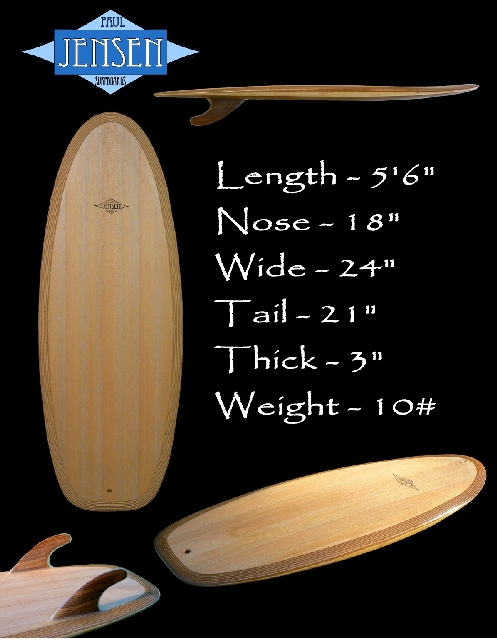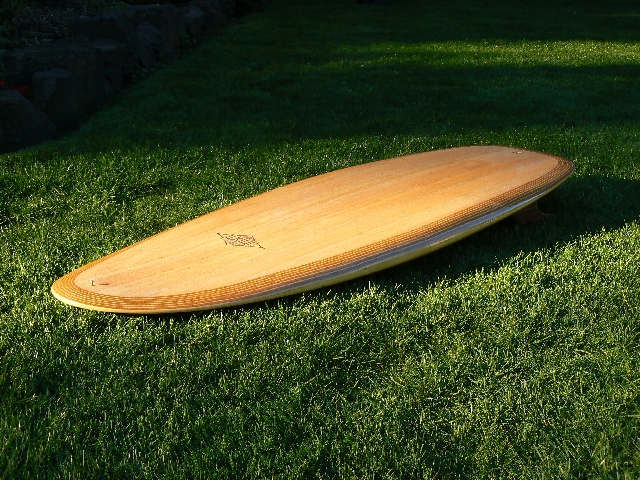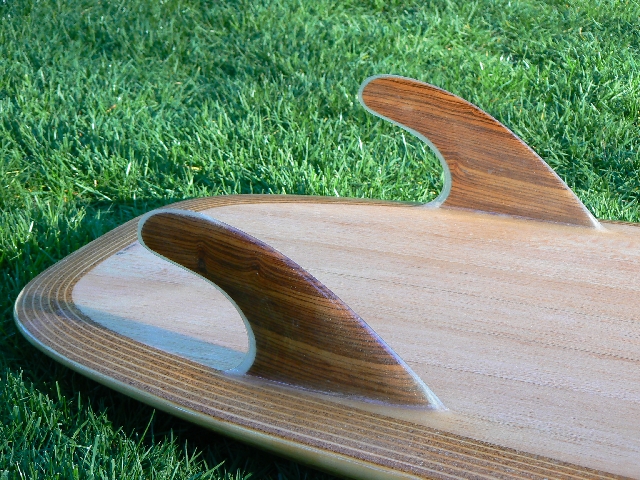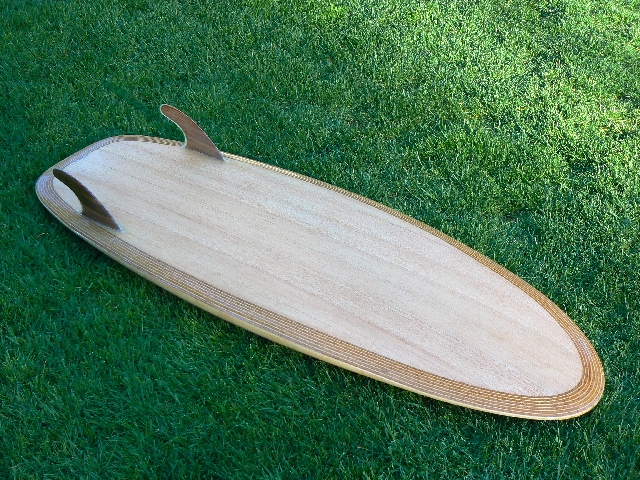
Ian let me give the 9-0 a go yesterday. My observations…paddles really well…feels balanced when carrying and paddling…no problem catching waves… high quality craftsmanship. It went fast and felt right most of the time…but the tail slid out on me a few times…when prone riding and getting hit by a section it would slide ass. When on a face it was holdin good though. On one particular good wave I was inspired to stand up after setting up with a belly take off…as I moved forward…maybe just around of forward of center…it slid out on me. I had similar problems with my 8-4 similar board…but fixed them with 6 inch deep fins after trying 4 and 5.inch deep. I think my board is flatter in the tail and has more weight so…those things influence the equasion.
All in all …I really liked
it and think with minor fin work …I would love to have it in my quiver.Rogleio
thanks.
Matt’s board looks interesting… and fun. I first saw a Simmons board back in the 80’s and wondered why people weren’t making them like that. Then when I was visiting Skip Frye one afternoon, I noticed an early marketing poster of RK’s for the Hydrodynamica film on his wall, and it struck up a conversation. I had been following the Terry Martin Replicas, and the Joe BauGuess replicas & new creations and inspirations, as well as takes on the subject by Manuel Caro of Mandalla, related stuff on The Grey Ghost site, and all of the articles in Surfer’s Journal (not to mention all of the archives and links on the web right now from a mix of surfers and shapers like Tristan Mausse, Sean Wild, Zamora, McCallum, RK, Chip, Swift, Benoit Jean, Paulo Jacinto, Renaud cardinal, Addiction Surfboards, Dano, Little Doogs, Rudy, Stevenson, Ciaravola, etc).
This has sparked enough inspiration in me to get me to cut one of my 10’4" longboard blanks in half this coming weekend, to create two of these “Simmons Inspired” creations… only I am using Bill Thrailkill’s twin box setup on one, and want to try to add a couple more (one on each side of the rail) just to see how it works.
My only questions now are, do I go with two 5’2" boards, or make one like 4’11" and one 5’5" or 4’9" and 5’7" or something like that? And should I go full-on Simmons specs, or go with the Flat bottom and hard tail like Bill has suggested to me on my others?
Anyone? Anyone? Bill? Anyone?
pictures just don’t do that board justice. one really needs to see it in person-it’s absolutley beautiful!
I strongly recommend checking the Shelter Surf shop site, they have a Brian Hilbers shaped board on there that owes as much to Greenough as to Bob S. No idea how if it works but it’s awesome looking! Oh yeah, the clip is great- it’s Joe Curren and Chris del Moro last December on the 6’ and 5’5" boards.
Can’t get it to load
Hey all, here’s a Simmons Spoon recreation in balsa by Greg Noll that I believe illustrates the slot concept. Interesting board!
Wow! I can see a scarf-joint on the one in his book, but this one is blended well… I would like to see someone shape one out of a solid slab… that would be a nightmare mowing through all of that stock!
Here’s a little spin I put turbo fins on it. This is a 5’9" from Ian Zamora that’s just so much fun. The turbos help me keep it on rail through a cutback…






Sick.
Here’ an added twist … no twist intended … Have Fun !!



and …an old Weber at Salt Creek 07’ Have Fun … !!



The 9’0 is a trimmer but like Proneman said. not much trimming up front. It cuts through the water smoothly and just keeps going. Put it on rail… you better be on the sweet spot. Thats where the challenge begins. Like what I said It rode how I expected it to ride… Its a very unique feeling. Heres the 9’oh on trim.

Here’s my second try at a mini Simmons inspired  board. Hope it loads! Mike
board. Hope it loads! Mike
And another. 
One more for now. This board has been laminated and  hotcoated. Just need to get in there and start sanding. Mike
hotcoated. Just need to get in there and start sanding. Mike
Hey Paul,
Was this board that you made back in March of 2006 a Simmons influenced Hollow? It sure shares a lot of the characteristics of the boards everyone is dubbing a “mini-Simmons”… Was this a concept that you had in mind based on Bob Simmons’ design characteristics? Just curious.





“Interpreting the Simmons Board” from www.legendarysurfers.com
In John Elwell’s detailed study of the contributions Bob Simmons made to surfing, published in a 1994 edition of The Surfer’s Journal, he wrote an analysis of the Simmons board:
"The Simmons surfboard is as strange an apparition today as it was when it first appeared. In its time it broke all the rules of the day. It represents a shift from heavy displacement to light displacement along with the application of scientific theory. It was a radical departure, far ahead of its time, like the designer, and misunderstandings hindered its full acceptance. Bob Simmons disregarded criticism and just went surfing, which was his great love; his surfing proved the validity of his boards along with their use by a small cadre of followers.
"From what he said and the body of research he had in his possession, along with a visual appraisal, one can get an idea of what he was pursuing. He was an erodynamicist and a mathematician. That viewpoint must be kept in mind.
"The boards had maximum width. Width was favored for the least resistance. Width plays a key role in delivering kinetic energy to the airfoil rail, the leading edge, that gives deflection. All planing hulls are deflectors. The airfoil is a special shape that is calculated. Width divided into length, is aspect ratio, giving a magic number related to lift. Width also allows the hull to leave a clean wake. An impressive example of the value of width is the bodyboard.
"The wide, unusually cambered, uplifted noses created a lot of criticism. The unknowing critics said they were pushing water, but they were in fact working, spreading the water, momentarily, to the high pressure rails before take off. In a tough spot, where the nose comes in contact with the water, in a steep takeoff or large chop, they lifted. Changing the noses was not a big deal to him, saying they stick out when we surf. He rejected points as too fragile and dangerous. Some of his early boards had points. Constant form, flat noses are perfectly acceptable in smooth water. Simmons opted for camber, because sea conditions can change rapidly due to weather changes.
“The outlines were fair parallelism, contiguous rails, fared-in near the tail for clean stable running. Non-uniform outline shapes were rejected, because of eddy flow resistance that increases with planing speed. This occurs at 10” in width. He is on record that trying to modify paddleboard shapes into surfboards was wrong; destroying the wide tail reduced early lift and clean resistance wakes. Those forms pulled the rail away from the wave and required a single fin, partly corrected with a tri-fin today, which undoubtedly would have been rejected, because of increased appendage drag. Rocker was rejected for reasons made obvious by his theory. ‘Ya just don’t need it!’
"He rejected the notion that wide tails were the cause of ‘spin out,’ and considered it a fin problem. He moved a small fin to each outboard rail at the end and towed them in to 10º. This is because the water is moving the fastest at these points as it leaves the hull. A single centered fin is in the low pressure area of the board and away from the wave. He simply expressed, you need more fin at low speeds and less at high speeds. Simmons and his ‘test pilots’ never spun out with dual fins, surfing the biggest and hardest breaking surf. However, he warned that non-uniform hull shapes could ‘spin out.’ This is because uneven side pressures build up, inducing a possible sudden yaw. These shapes require a deeper fin, increasing appendage resistance as the board surfs forward and sideways. He noted with criticism that narrow tails, give a tubing, sucking wake. Anything that has eddy flow resistance, was a ‘disaster’ and ‘not the way to go!’
"The rail and fins had a ‘chord value’ percentage dimension, to allow a smooth release of water flow, allowing the least amount of cavitation. An illustration was contained in a text he had. He dismissed this with a cackle by saying, ‘Generally just lead round, end thin, and that is good enough.’ A true planing hull adjusts itself with speed, where it eventually works itself to a minimum in the aft inside section of a surfboard, unless as Simmons and others found out, it leaves the water in a launch and a skip. He dumped ultralight to keep the boards in the water. Due to the extreme thinness in the nose and tail, he recommended two coats of glass, and even a coat of marine fiberglass paint to protect the board from the destructive rays of the sun, ‘… if you want to keep it.’ He added, ‘the extra weight doesn’t make that much difference.’
"The center of gravity, was precisely placed on these boards. Load has to be forward of lift, a commonly known fact in aerodynamics and naval architecture. Most of his boards would balance on a sawhorse in the middle or slightly forward. The decks were domed smoothly into the rails, shedding water rapidly off the airfoil, this concept greatly reduced unneeded weight. A density calculation was done of materials to get an exact flotation for the weight of load, to barely support the rider. Some surfers, skeptical of this, asked for more flotation and he complied reluctantly.
"A very few of his boards had concave bottoms. Simmons said he did this to get air into them briefly, reducing the suction. The center of the hull has a low pressure flow down the center area anyway. He reduced it even more with a concave. But his concentration was focused on what was happening out on the rail.
"Simmons had piles of computations in advanced math. (All of these are apparently lost, along with test models.) His boards were a complex creation. His efforts were the result of a comprehensive scientific approach using experimentation and Newtonian mechanics. However, planing hulls suffer a penalty at low speed, struggling to get over the hump. Resistance points can be identified where water breaks away in small waves. Simmons attempted to solve this by flow slotting aft of the nose, and spoiler slots in the tail. Only a few boards had this feature. It was very difficult to do correctly. Each of these boards had to be surfed without glassing, with a tack coat of resin. This was applied ‘boomerang science;’ throw and adjust to desired performance. He was also checking the desired attack angle; the immersed, thin-wide tail had to be between 15-20º. This was the secret for quick and early lift for gaining position. Strategically, Simmons wanted to be in the wave first and as soon as possible, for the right-of-way, second he wanted speed, to cover distance for long rides. Big waves and long rides were his criteria for performance. Everything else was folly! He was successful at this. It was commonly said in his day, ‘No one has ever gone as fast on a surfboard!’ It was noted by contemporaries the he usually got the best rides.
“Length plays a role in speed, to a point. Appropriate length captures the maximum principle of resurgence, as water is pushed away, it rebounds and assists the hull. The only way a non-contiguous narrow shaped form can come close to a wide hull is to increase length, but it will never lose its lateral instability. He settled for a 10’6” for bigger surf and 8’ for quick, hard breaking inside breaks."
“Simmons was the most objective surfer I ever met” – Dempsey Holder
“Pat Curren referred to us as Simmons’ test pilots” – John Elwell “Simmons had such good wave knowledge, that I would watch him instead of waves. When he started moving out, I followed him” – Phil Edwards
He was also checking the desired attack angle; the immersed, thin-wide tail had to be between 15-20º. This was the secret for quick and early lift for gaining position.
I can’t seem to wrap my head around this…
Is the implication that he engineered his board so that board naturally listed at this particular angle?
The slots as a countermeasure for the inefficiencies of the hull at low speed…gonzo.




a simmons has neutral rails, going from high in front to low in back. an s-deck, displacement hull and parallel outline.rocker up front, low in the back .i’m not dissin’ the casper board, but if you put it, and a liddle next to a simmons it would be obvious which one is more closely related to the simmons.